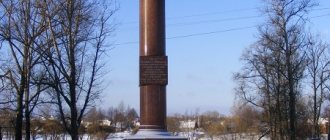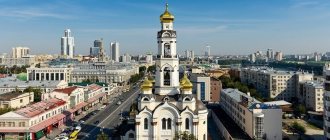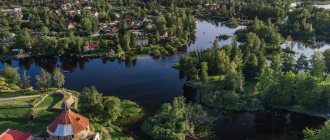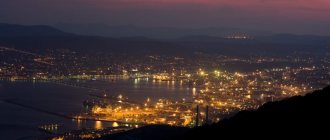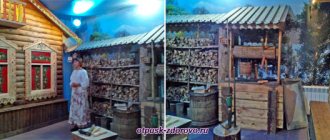Tver is an ancient Russian city with a population of half a million, the administrative center of the Tver region, bordering the Moscow region. The famous Volga River and its two large tributaries flow through the city: Tvertsa and Tmaka. And through Tver there is a road and railway connecting Moscow and St. Petersburg.
View of the Afanasy Nikitin embankment, Tver city
Brief history of Tver
It is pleasant to consider the year 1135 as the founding date of Tver, although no one knows the exact date of the formation of Tver as a city (fortress). To round it off, we can say that Tver and Moscow are the same age. From the beginning of the 13th century to the middle of the 15th century, the Tver Principality actively developed and competed with the Moscow Principality for the title of capital of the Russian lands. The heat and constant blows from the Mongol-Tatars added to the heat. In 1488, Ivan III annexed Tver to the Moscow Principality, thereby extinguishing all development potential. Tver ceased to exist as a separate principality, but still remained a major trade, craft and cultural center.
In the 18th century, after the founding of St. Petersburg, Tver was assigned a new role. Located on the road between Moscow and St. Petersburg, Tver secretly had the status of a “transshipment point.” Such famous personalities as, for example, Empress Catherine II or the writer and poet A.S. Pushkin regularly stopped here. In 1763, a severe fire occurred in Tver, destroying the entire central part. By order of Catherine II, the capital's architects were sent to Tver, thanks to which Tver is now called “little St. Petersburg.”
In the 19th century, Tver was connected to Moscow and St. Petersburg by railway and turned into an industrial city: weaving factories, paper factories, sawmills, etc. were opened. Schools and colleges are also actively opening.
During Soviet times (from 1931 to 1990), Tver was renamed Kalinin. Many plants and factories were also opened.
Now Tver is a quiet, calm, but at the same time quite developed city: not too big to get lost in the frantic rhythm, but not too small to be called a provincial backwater. There is a lot of greenery and water, tourists love to come here: some to admire the ancient architecture, and others to take a break from the noise of big cities.
Tver in a photograph by Prokudin-Gorsky, 1910
The burning of Moscow as revenge for aggressiveness
Subsequently, Muscovites tried to hurt Tver at every opportunity. In 1327, an anti-Mongol uprising began in the northern city - Tver residents beat the tribute collectors. Moscow prince Ivan Kalita and his squad willingly took part in the punitive expedition. Together with the Mongols, he approximately punished and burned Tver, which then hardly recovered for almost half a century.
Burning of Tver. Miniature from a chronicle of the 16th century. (wikipedia.org)
The next stage of the confrontation between the two principalities dates back to the beginning of the reign of Dmitry Ivanovich in Moscow, who had yet to achieve the honor of being called Donskoy. In 1367, the 17-year-old prince decided that Tver, which had not yet recovered from the devastation, would become his easy prey. Mikhail Alexandrovich Tverskoy really did not have enough strength to resist, but he had a strong ally. Mikhail wisely married his sister to the Lithuanian prince Olgerd, a noble commander who had recently completely defeated the Mongols themselves at the Battle of Blue Waters. Olgerd did not refuse to help his brother-in-law.
Frightened by the Lithuanians, Dmitry retreated to Moscow, but did not abandon his plans. He, under the pretext of some church litigation, lured Mikhail to visit him and put him in prison along with his entire retinue. The Tver residents did not remain in captivity for long. An inspection from the Horde came to Moscow, and Dmitry, realizing that he could get into trouble for arbitrariness, released his captives. As a ransom, he took one of the volosts from Tver.
Offended and fleeced, the Tver prince again complained to his brother-in-law. The joint army of Lithuanians and Tver residents besieged Moscow. Dmitry managed to sit out in the Kremlin: the opponents did not dare to storm the white-stone stronghold, and its siege would have taken too much time. But all of Moscow, which remained outside the Kremlin walls, was devastated and burned. The loser Dmitry had to return the ill-fated volost, because of which he almost lost his capital.
Olgerd's siege of Moscow in 1368, stamp of Lithuania, 1932. (personal collection of the author)
Burnt Moscow took two years to rebuild. After which the persistent Dmitry again moved to Tver. He thought that he had everything figured out: Olgierd fought with the Teutonic Order in 1370 and had no time for Russian affairs. Muscovites plundered and burned the towns of Tver, taking away many civilians. Closer to Christmas, Olgierd dealt with the Order and found time to help Mikhail. Their army again approached the Moscow Kremlin, but again refused to storm the stronghold. Dmitry escaped with a slight fright.
The Tver prince understood that with the help of the Lithuanians alone he could not curb Moscow’s appetite. He went to the Horde, where at that time the Temnik Mamai ruled, who actually usurped power. Mikhail managed to please Mamai and returned home with a label for the reign of Vladimir - a sign of supreme power and the main reason for the feud between Moscow and Tver. Unexpectedly, Dmitry declared that the Horde was not his decree and refused to give Vladimir to his rival. Moreover, he soured the Horde ambassadors with bribes that he was able to return the Vladimir label to himself. After this incident, the authority of Moscow among the Russian principalities grew sharply: it became clear that the local prince was not afraid of the Mongols.
Over the years, not only Dmitry Ivanovich’s authority grew stronger, but also his leadership abilities. In 1372 he defeated the Lithuanians in open battle. Not the entire army of Olgerd suffered defeat, but only its vanguard, but the Lithuanian prince did not dare to fight a big battle. Three years later, Dmitry again attacked Tver. The reason for this was given to him by Prince Mikhail, who persuaded Mamai to return the ill-fated Vladimir label to him. Temnik returned the label and even promised to protect Tver in the event of an attack by Moscow, but the support was only verbal. This time Olgerd did not stand up for his relative, fearing the strong Moscow army, especially since Dmitry united the forces of several principalities dependent on Moscow and enlisted the support of Novgorod. As a result, Tver found itself alone against many enemies. Prince Mikhail bravely defended his capital, but the wooden walls could not stand it. The Tver prince was forced to admit defeat. Under the terms of capitulation, he had to call Dmitry “Big Brother” and give him several Tver volosts.
After the destruction of Moscow by Tokhtamysh in 1382, Mikhail once again tried to convince the Mongols to return the Vladimir label to him. The attempt was unsuccessful. Tver, however, retained its independence, but it could no longer compete in strength with Moscow, which quickly recovered from another burning.
Briefly about the sights of Tver
The most popular attractions of Tver include the following:
- Tver Imperial Travel Palace
- Mikhail Yaroslavich Embankment
- Monument to A. S. Pushkin
- Starovolzhsky Bridge
- Stepan Razin Embankment
- Urban development of the 18th century
- Afanasy Nikitin Embankment
- Former river station
- Assumption Cathedral
- Monument to Afanasy Nikitin
- Church of the Resurrection of Christ
- Pedestrian street Trekhsvyatskaya
- House of merchant Nechaev
- Monument to Mikhail Krug
- Island of Memory, Obelisk of Victory and Eternal Flame
- Tver Drama Theater
- Ascension Cathedral
- Mikhail Tverskoy Square with the monument to Prince Mikhail Yaroslavich
- Former post office building with clock
- St. Catherine's Convent
- White Trinity Church
- Nativity of Christ Convent
- Proletarka District – Morozovsky Town
You can read detailed information about the sights of Tver and see beautiful photographs here.
Monument to Tver Prince Mikhail Yaroslavich on Sovetskaya Street in Tver
Krylova Street
Avaev Almshouse
Avaevskaya almshouse, Krylova street, Tver
Fire station 1915
Fire station 1915, Krylova street, Tver
Hotel "Tverskaya"
Krylova Street emerges onto Smolensky Lane, and there, at the intersection with Vagzhanova Street, stands the Tverskaya Hotel. Tver residents call it simply - Ryumka.
This is the tallest building in Tver, its height is 77 meters. Built 1977-89. On the upper floors there is a panoramic platform over the city.
Interesting facts about Tver
- From the XII to the XVIII centuries. in Tver on the right bank of the Volga stood the Tver Kremlin, which finally burned down in a fire in 1763
- In the Middle Ages, the Tver Principality was so strong that it seriously competed with the Moscow Principality
- The coat of arms of Tver depicts a golden stool with green upholstery, on which lies a golden crown decorated with green gems.
- Tver merchant Afanasy Nikitin became the first European to reach the shores of India. This happened in the 15th century.
- In 1716, the first secular educational institution opened in Tver - the Digital School.
- After the fire of 1763, Tver was built up by the capital's architects. As a result, a three-ray street appeared in Tver. Rome, Versailles and St. Petersburg became famous for the same buildings.
- The first tram line in Tver was opened in 1901.
- At the end of the 19th century, the first district in Russia for workers was built in Tver - Morozovsky town
- After the end of the Great Patriotic War, Tver was included in the list of 15 most important cities of the RSFSR, which should have been restored as a priority.
- From 1931 to 1990 Tver was called Kalinin
- Peak temperatures were recorded in 1978 (-43.8°C) and in 2010 (+38.8°C)
Barracks "Paris" in Morozovsky town, Tver
Soviet street
This is the main street of the city. Appeared as a result of a fire in 1763. Designed it along with two other beams by P.R. Nikitin. Since the project was signed by Catherine II, the street was named Ekaterininskaya.
Under Paul I, who had a strained relationship with his mother, the street was renamed Millionnaya, but it received its current name in 1919.
Transfiguration Cathedral
Spaso-Preobrazhensky Cathedral, Sovetskaya street, Tver
The first Transfiguration Cathedral has stood here since 1285, which did not stop it from being blown up in 1935 and a monument to Kalinin being erected. Now the monument has been demolished and a new temple is being built.
Spaso-Preobrazhensky Cathedral, Sovetskaya street, Tver
Chapel of All Tver Saints
Chapel of All Tver Saints, Sovetskaya Street, Tver
Imperial Travel Palace
Imperial Travel Palace, Tver
If we continue the comparison with St. Petersburg, then the Imperial Travel Palace is the Hermitage. Now it houses an art gallery.
It was built in the 18th century in the classicism and baroque styles. Since Tver stood on the Tsar’s Road from St. Petersburg to Moscow, Imperial Travel Palaces were built along the way for the rest of the crowned princes.
Imperial Travel Palace, Tver
Imperial Travel Palace, Tver
Sculpture of Simeon Tverskoy
Statue of Simeon Tverskoy, Sovetskaya street, Tver
Sculpture of Simeon Tverskoy against the background of the Museum of Local Lore, Sovetskaya Street, Tver
Museum of Local Lore
Museum of Local Lore, Sovetskaya street, Tver
To the east, the travel palace is adjacent to the former real school. Now here is the Tver United Museum.
Museum of Local Lore, Sovetskaya street, Tver
Medical University
Tver State Medical University, Sovetskaya street, Tver
Tver State Medical University, Sovetskaya street, Tver
Eastern wing of TSMU, Sovetskaya street, Tver
Wolf's House, Sovetskaya Street, Tver
Wolf's House, Sovetskaya Street, Tver
Building of the Tver and Kashin dioceses of the Russian Orthodox Church, Sovetskaya street, Tver
Governor's House, Sovetskaya Street, Tver
The governor's house was built in the classicist style. C. Rossi and sculptor I. Vitali participated in the decoration of the interior. On December 16, 1941, it was on this building that the Red Banner was hoisted as a sign of the liberation of then Kalinin from the Nazi occupation.
Drama Theater
Drama Theatre, Sovetskaya street, Tver
The theater itself begins its history in the 18th century. And the building itself in the Stalinist Empire style was built in 1951.
Drama Theatre, Sovetskaya street, Tver
Arch in Empire style, Teatralny proezd, 1, Tver
Teatralny Proezd
Teatralny Proezd stretches south from the Drama Theater until after 100 meters it ends at Tverskaya Square (more about it below).
Immediately after the parking lot there is a bust of Pushkin. It was staged in 1972 by E.F. Belashov.
Monument-bust to Karl Marx
Monument-bust to Karl Marx, Sovetskaya street, Tver
Library named after A.M. Gorky
Library named after A.M. Gorky, Sovetskaya street, Tver
Sovetskaya street, building 7, Tver
Sovetskaya street, building 7, Tver
Sovetskaya street, building 7, Tver
Sovetskaya street, building 7, Tver
Sovetskaya street, building 7, Tver
Ascension Cathedral
Ascension Cathedral, Tver
It was built in 1751-1769 on the site of a burnt wooden church. The bell tower was completed later - in the 19th century. Since 1935, the temple was used as a local history museum. In the 1990s, the Russian Orthodox Church was returned.
Bell tower of the Ascension Cathedral, Tver
Square of the Holy Blessed Prince Mikhail of Tverskoy
A little earlier this square was called Sovetskaya, and from the very foundation it was called Semicircular. Just from it three rays of streets diverge: Novotorzhskaya, Sovetskya and Volny Novgorod. The entire three-beam system was designed by P.R. Nikitin.
Equestrian statue of Mikhail Tverskoy
The 8.5-meter monument was opened in 2008, then still on Soviet Square. Sculptor – Andrey Kovalchuk.
The granite pedestal is covered with a belt with Slavic ornaments, and a bronze shield is also attached to the front.
And if we continue the analogies with Rome, then the prototype will be the statue of Marcus Aurelius on the Capitol, the only equestrian statue preserved from Antiquity.
Sovetskaya street, building 29, Tver
Post office, Sovetskaya street, Tver
Stele "City of Military Glory" on Pushkin Square
It was installed in honor of awarding Tver the title “City of Military Glory”. On the column itself there is a cartouche with this presidential decree, on the opposite column there is the coat of arms of Tver.
The column is surrounded by four pylons with bas-reliefs of the battle of 1317 with the Poles, the Patriotic War of 1812 and the Great Patriotic War.
Sovetskaya street, building 57, Tver
House with a belvedere, Sovetskaya street, Tver
Cathedral Mosque
Cathedral Mosque, Sovetskaya street, Tver
The mosque was opened in 1906 with the permission of the provincial government, but it only worked until 1935. It was returned to Muslims in 1992, and in 2008 it was reconstructed.
The mosque was built in the neo-Moorish style. The height of the minaret is 16.3 meters.
Cathedral Mosque, Sovetskaya street, Tver
Church of the Transfiguration
Church of the Transfiguration, Sovetskaya street, Tver
The first Catholic church was erected on this site in 1864 and destroyed in 1974. Construction of the current one began in 1994 and continued for 8 years.
The architecture combines elements of Gothic and Art Nouveau. The belfry is especially interesting.
Church of the Transfiguration, Sovetskaya street, Tver
Vagzhanova Street
Chernobyl Heroes Square
Monument to the liquidators of the Chernobyl disaster, Chernobyl Heroes Square, Tver
This square remained nameless for a long time and received its name on October 21, 2006, when the monument to the “Liquidators of the Chernobyl Disaster (1986-1990)” was unveiled.
Church of the Nativity of the Virgin Mary
Zhigareva Street
Goat Museum
Bar "Lublin", Tver
MiG-27
MiG-27, Tver
Sorrow Church
Sorrow Church, Andrei Dementyev Street, Tver
Sorrow Church, Andrei Dementyev Street, Tver
Zhukov Square
Zhukov Square, Tver
College named after Konyaeva
College named after Konyaeva, Tver
College named after Konyaeva, Tver
College named after Konyaeva, Tver
Silver Street
Living room Galyani
Hotel Galyani, Tver
Plyushkin Museum
Plyushkin Museum, Serebryannaya Street, Tver
Plyushkin Museum, Serebryannaya Street, Tver
Synagogue
Synagogue, Pushkinskaya street, Tver



